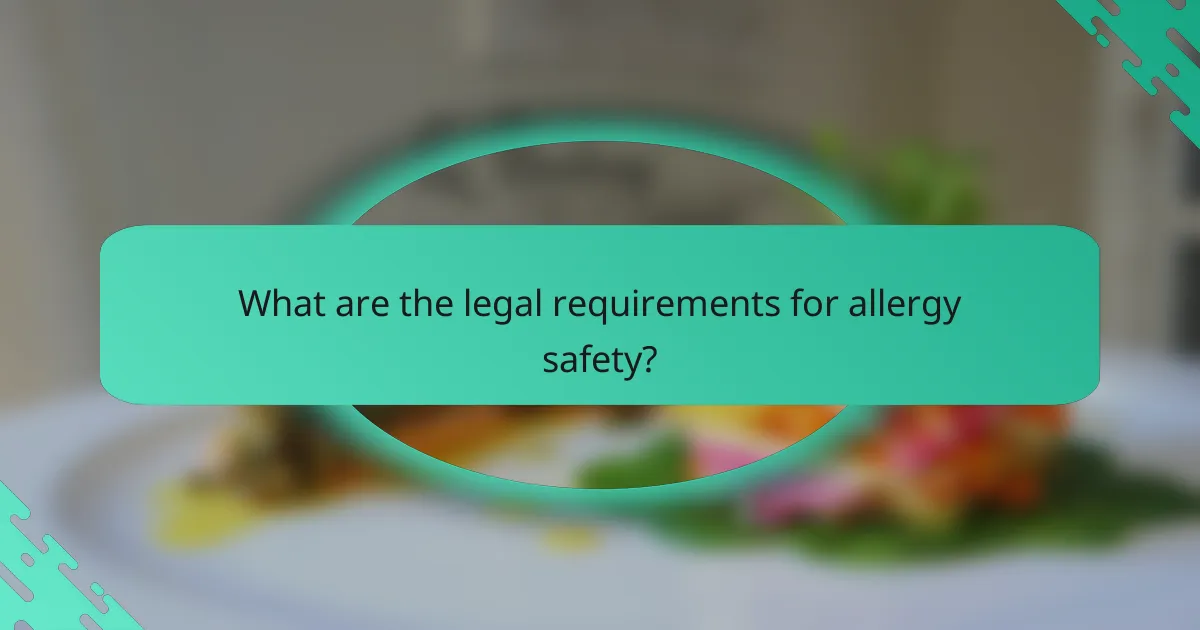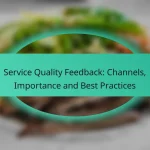In today’s food industry, adopting allergy-friendly practices is essential for ensuring the safety and satisfaction of customers with food allergies. By focusing on ingredient transparency, cross-contamination prevention, and staff training, local services can create a safer dining environment. Clear labeling and effective communication further empower customers to identify safe options and enjoy their meals with confidence.

What allergy-friendly practices can local services implement?
Local services can adopt several allergy-friendly practices to ensure the safety and satisfaction of customers with food allergies. These practices include ingredient transparency, cross-contamination prevention, staff training on allergens, regular equipment sanitization, and clear labeling of products.
Ingredient transparency
Ingredient transparency involves openly sharing detailed information about the components of food and products. This allows customers to make informed choices based on their specific allergies or dietary restrictions.
Services should provide accessible ingredient lists, either online or in-store, and highlight any common allergens. This practice builds trust and helps customers feel secure in their selections.
Cross-contamination prevention
Preventing cross-contamination is crucial for ensuring the safety of allergy-prone customers. This can be achieved by using separate utensils, equipment, and preparation areas for allergenic ingredients.
Establishing strict protocols, such as color-coded tools or designated cooking spaces, can minimize the risk of accidental exposure. Regular audits and checks can help maintain these standards effectively.
Staff training on allergens
Comprehensive staff training on allergens is essential for creating a safe environment. Employees should understand the various types of allergies and the importance of preventing cross-contact.
Regular training sessions can keep staff updated on best practices and ensure they know how to communicate effectively with customers regarding their allergy concerns.
Regular equipment sanitization
Regular sanitization of equipment is vital to eliminate allergen residues that could pose risks. Establishing a cleaning schedule that includes thorough washing of all cooking tools and surfaces can significantly reduce contamination chances.
Using allergen-specific cleaning products can further enhance safety. Documenting these cleaning practices can provide accountability and assurance to customers.
Clear labeling of products
Clear labeling of products is a fundamental practice for allergy-friendly services. Labels should include all ingredients and highlight any potential allergens prominently.
Using standardized symbols or color codes can help customers quickly identify safe options. This practice not only aids in decision-making but also demonstrates a commitment to customer safety.

How can customers identify allergy-friendly options?
Customers can identify allergy-friendly options by looking for clear labeling, engaging with restaurant staff, and utilizing online resources. Understanding how to navigate menus and communicate needs effectively is essential for ensuring safety and satisfaction.
Online reviews and ratings
Online reviews and ratings can provide valuable insights into a restaurant’s allergy-friendly practices. Customers often share their experiences regarding how well establishments accommodate dietary restrictions, which can help others make informed choices. Look for keywords like “allergy-friendly” or “safe for allergies” in reviews to gauge reliability.
Platforms such as Yelp or TripAdvisor can be particularly useful, as they often feature detailed customer feedback. Pay attention to recent reviews, as practices may change over time.
Menu customization requests
Many restaurants allow for menu customization, which can be a key strategy for identifying allergy-friendly options. When dining out, don’t hesitate to ask staff about modifying dishes to exclude allergens. This proactive approach can help ensure your meal meets your dietary needs.
Be specific about your allergies when making requests. For example, if you are allergic to nuts, ask if a dish can be prepared without them or if there are safe alternatives. This not only helps you but also informs the staff about the importance of allergen management.
Certifications from allergen organizations
Certifications from recognized allergen organizations can serve as a reliable indicator of a restaurant’s commitment to allergy-friendly practices. Look for establishments that display certifications, which often signify adherence to specific safety standards. These certifications can include gluten-free, nut-free, or other allergen-specific designations.
Research the certifying bodies to understand their criteria and ensure they are reputable. For instance, organizations like the Gluten-Free Certification Organization (GFCO) or the Allergy Standards Limited (ASL) provide guidelines that restaurants must follow to earn their seals. This can give you added confidence in your dining choices.

What safety measures should be in place for allergy sufferers?
Effective safety measures for allergy sufferers include clear communication, proper training, and emergency protocols to minimize risks. Implementing these practices ensures a safer environment for individuals with allergies, enhancing their overall experience.
Emergency response protocols
Emergency response protocols are essential for quickly addressing allergic reactions. Establish a clear plan that includes immediate access to first aid kits, epinephrine auto-injectors, and trained personnel who can act swiftly in case of an emergency.
Regular drills should be conducted to ensure all staff members are familiar with the procedures. This preparation can significantly reduce response times and improve outcomes for those experiencing severe allergic reactions.
Allergen-free zones
Creating allergen-free zones helps protect individuals with specific allergies. Designate areas where common allergens, such as nuts or gluten, are strictly prohibited, and clearly mark these zones to inform both staff and customers.
Regular cleaning and maintenance of these zones are crucial to prevent cross-contamination. Consider using separate utensils and equipment to further ensure safety in these designated areas.
Regular staff allergen training
Regular training for staff on allergen awareness is vital for maintaining a safe environment. Training should cover the identification of allergens, proper food handling techniques, and how to communicate effectively with customers about their dietary needs.
Consider implementing refresher courses every few months to keep staff updated on best practices and any changes in regulations. This ongoing education fosters a culture of safety and attentiveness towards allergy sufferers.

How do local services assure customers of safety?
Local services assure customers of safety by implementing clear protocols, transparent communication, and responsive feedback systems. These practices help build trust and ensure that customers feel secure when dining or shopping, especially those with allergies.
Transparent communication
Transparent communication involves clearly sharing information about ingredients, preparation methods, and potential allergens. Services often provide detailed menus that highlight allergen content, allowing customers to make informed choices.
Additionally, staff training is crucial; employees should be knowledgeable about allergens and able to answer customer inquiries confidently. This openness fosters a sense of safety and encourages customers to voice their concerns.
Customer feedback systems
Effective customer feedback systems allow businesses to gather insights on their allergen management practices. This can include surveys, suggestion boxes, or direct communication channels where customers can report their experiences.
By actively seeking feedback, local services can identify areas for improvement and address any safety concerns promptly. This responsiveness not only enhances safety but also demonstrates a commitment to customer care.
Visible allergen policies
Visible allergen policies are essential for reassuring customers about safety measures. Many establishments display their allergen policies prominently, either on their websites or within the premises, detailing how they handle allergens and prevent cross-contamination.
These policies should be easy to understand and accessible, allowing customers to quickly assess the safety of their choices. Regular updates to these policies, based on customer feedback and new regulations, further enhance trust and reliability.

What are the legal requirements for allergy safety?
Legal requirements for allergy safety primarily focus on ensuring that food products are safe for consumers with allergies. This includes adherence to food safety regulations and proper labeling laws to inform customers about potential allergens.
Food safety regulations
Food safety regulations are designed to protect consumers from foodborne illnesses and allergens. In many countries, these regulations require food businesses to implement Hazard Analysis and Critical Control Points (HACCP) systems to identify and manage risks associated with allergens.
For example, restaurants must ensure that cross-contamination is minimized by using separate utensils and preparation areas for allergenic ingredients. Regular training for staff on allergy awareness and safe food handling practices is also crucial to comply with these regulations.
Labeling laws
Labeling laws mandate that food products clearly indicate the presence of common allergens such as peanuts, tree nuts, dairy, eggs, soy, wheat, fish, and shellfish. In the United States, the Food Allergen Labeling and Consumer Protection Act (FALCPA) requires that these allergens be listed in plain language on packaging.
Businesses should regularly review their labeling practices to ensure compliance with local laws, as regulations may vary by country. For instance, in the European Union, allergen information must be provided for both pre-packaged and non-pre-packaged foods, often requiring clear signage in restaurants and cafes.


